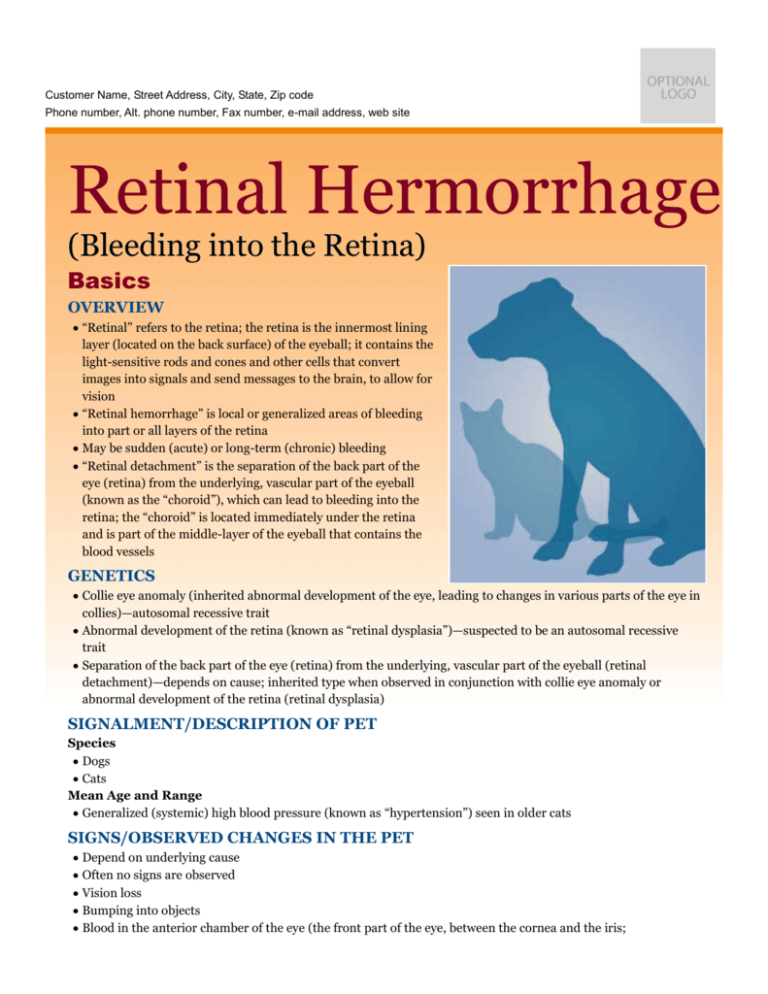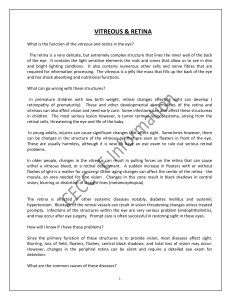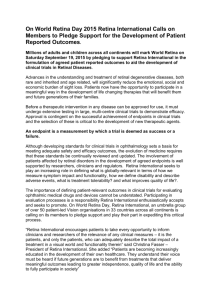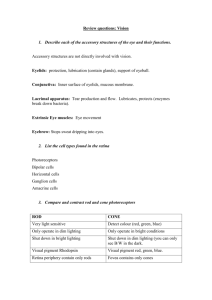retinal_hermorrhage
advertisement

Customer Name, Street Address, City, State, Zip code Phone number, Alt. phone number, Fax number, e-mail address, web site Retinal Hermorrhage (Bleeding into the Retina) Basics OVERVIEW • “Retinal” refers to the retina; the retina is the innermost lining layer (located on the back surface) of the eyeball; it contains the light-sensitive rods and cones and other cells that convert images into signals and send messages to the brain, to allow for vision • “Retinal hemorrhage” is local or generalized areas of bleeding into part or all layers of the retina • May be sudden (acute) or long-term (chronic) bleeding • “Retinal detachment” is the separation of the back part of the eye (retina) from the underlying, vascular part of the eyeball (known as the “choroid”), which can lead to bleeding into the retina; the “choroid” is located immediately under the retina and is part of the middle-layer of the eyeball that contains the blood vessels GENETICS • Collie eye anomaly (inherited abnormal development of the eye, leading to changes in various parts of the eye in collies)—autosomal recessive trait • Abnormal development of the retina (known as “retinal dysplasia”)—suspected to be an autosomal recessive trait • Separation of the back part of the eye (retina) from the underlying, vascular part of the eyeball (retinal detachment)—depends on cause; inherited type when observed in conjunction with collie eye anomaly or abnormal development of the retina (retinal dysplasia) SIGNALMENT/DESCRIPTION OF PET Species • Dogs • Cats Mean Age and Range • Generalized (systemic) high blood pressure (known as “hypertension”) seen in older cats SIGNS/OBSERVED CHANGES IN THE PET • Depend on underlying cause • Often no signs are observed • Vision loss • Bumping into objects • Blood in the anterior chamber of the eye (the front part of the eye, between the cornea and the iris; accumulation of blood known as “hyphema”) • Evidence of bleeding elsewhere—small, pinpoint areas of bleeding (known as “petechia”); bruises or purplish patches under the skin, due to bleeding (known as “ecchymoses”); black, tarry stools due to the presence of digested blood (known as “melena”); blood in the urine (known as “hematuria”) • Whitish appearing pupil (known as “leukocoria”), with or without reddish coloration behind the lens • Abnormal light reflexes of the pupil; the pupil is the circular or elliptical opening in the center of the iris of the eye; light passes through the pupil to reach the back part of the eye (retina); the iris is the colored or pigmented part of the eye; the pupil constricts or enlarges (dilates) based on the amount of light entering the eye; the pupil constricts with bright light and enlarges in dim light—these actions are the “light reflexes of the pupil” CAUSES Congenital (Present at Birth) • Separation of the back part of the eye (retina) from the underlying, vascular part of the eyeball (retinal detachment) secondary to congenital (present at birth) malformations in the eye • Abnormal development of the vitreous and retina (vitreoretinal dysplasia) or the retina (retinal dysplasia); the “vitreous” is the clear, gel-like material that fills the back part of the eyeball (between the lens and the retina) • Retinal defects Acquired (Condition That Develops Sometime Later in Life/After Birth) • Trauma • Generalized (systemic) high blood pressure (hypertension), especially in old cats—kidney disease; heart disease; increased levels of thyroid hormone (known as “hyperthyroidism”); increased levels of steroids produced by the adrenal glands (known as “hyperadrenocorticism” or “Cushing's syndrome”); high blood pressure of unknown cause (condition known as “idiopathic hypertension”) • Intoxication—various compounds, including dicumarol (an anticoagulant, to stop blood from clotting); paracetamol (a pain reliever); sulfonamide (type of antibiotic) • Infectious disease—Rickettsia rickettsia (Rocky Mountain spotted fever), Ehrlichia, cryptococcosis (a deep fungal infection) • Cancer—such as lymphoma, plasma-cell myeloma • Blood disorders—blood-clotting disorders (such as von Willebrand's disease); severely low red blood cell counts (known as “severe anemia”); low platelet count (known as “thrombocytopenia”); immune protein from a single clone of cells in the gamma region of a protein analysis of blood (known as a “monoclonal gammopathy”) and a condition in which increased protein in the blood leads to sludging of the blood (known as “hyperviscosity syndrome”) • Retinal disease secondary to diabetes mellitus (“sugar diabetes”; condition known as “diabetic retinopathy”) • Separation of the back part of the eye (retina) from the underlying, vascular part of the eyeball (retinal detachment) • Immune-mediated inflammation of blood vessels (known as “vasculitis”) RISK FACTORS • Generalized (systemic) high blood pressure (hypertension) • Blood clotting disorders • Blood disorders Treatment HEALTH CARE • Depends on the cause • Usually initially treated as inpatients—sometimes in intensive care for maximal follow-up • Intoxications—often require specific treatment • Consider referral to a veterinary ophthalmologist (eye specialist) for a more detailed examination • Supportive care often needed ACTIVITY • Separation of the back part of the eye (retina) from the underlying, vascular part of the eyeball (retinal detachment)—cage rest until the retina is reattached (if reattachment is possible) DIET • Depends on underlying cause • Dietary restrictions may be necessary, if primary cause is related to liver or kidney disease SURGERY • Surgery—refer the pet to a veterinary ophthalmologist (eye specialist) for surgical removal of the vitreous (known as “vitrectomy”) and/or retinal reattachment surgery; the “vitreous” is the clear, gel-like material that fills the back part of the eyeball (between the lens and the retina) Medications Medications presented in this section are intended to provide general information about possible treatment. The treatment for a particular condition may evolve as medical advances are made; therefore, the medications should not be considered as all inclusive • Depend on underlying cause • Steroids administered by mouth or by injection—if workup is declined and infectious disease is unlikely; prednisolone; especially for separation of the back part of the eye (retina) from the underlying, vascular part of the eyeball (retinal detachment) as a sequela to trauma • Chloramphenicol or other broad-spectrum antibiotic administered by mouth or by injection—if bacterial infectious disease is suspected; may be administered at the same time as steroids are being administered • Primary generalized (systemic) high blood pressure (hypertension)—treat as required; often combined with steroid treatment, medications to remove excess fluid from the body (known as “diuretics,” such as furosemide), and calcium channel blockers • Azathioprine administered by mouth—type of chemotherapy, used to control inflammation for immunemediated separation of the back part of the eye (retina) from the underlying, vascular part of the eyeball (retinal detachment); combine with steroid treatment; may be used in immune-mediated disease involving the back of the eye • Itraconazole (an antifungal medication)—for cryptococcosis or other deep fungal infection • Flunixin meglumine—may be used in dogs if eye is inflamed and infectious causes have not been ruled-out Follow-Up Care PATIENT MONITORING • Repeated monitoring—required to ensure that condition subsides and to follow changes in the retina • Azathioprine treatment—a complete blood count (CBC), platelet count, and liver enzyme analysis should be performed every 2 weeks for the first 2 months, then periodically POSSIBLE COMPLICATIONS • Separation of the back part of the eye (retina) from the underlying, vascular part of the eyeball (retinal detachment) • Blindness • Impaired vision • Long-term (chronic) inflammation of the iris and other areas in the front part of the eye (known as “uveitis”) • Glaucoma (increased pressure within the eye) EXPECTED COURSE AND PROGNOSIS • Depend on cause • Most retinal hemorrhages are small lesions, observed during examination of the eye; usually heal rapidly with no visual problems • Blood from preretinal bleeding—usually reabsorbed within a few weeks to several months, if localized • Larger or repeated bleeding—may be followed by development of scar tissue, which may cause retinal detachment • Bleeding within the retina—blood is reabsorbed within several weeks to months; may produce retinal scarring • Retinal hemorrhage due to generalized (systemic) disease are usually more serious and have an uncertain prognosis Key Points • Blind pets, especially cats, can adapt remarkably well and live a good-quality life • Consider euthanasia of young puppies with severe bleeding in both eyes (known as “bilateral hemorrhage”) due to congenital (present at birth) abnormalities • Dogs with bleeding in one eye due to congenital (present at birth) abnormalities can function as pets but should not be used for breeding Enter notes here Blackwell's Five-Minute Veterinary Consult: Canine and Feline, Fifth Edition, Larry P. Tilley and Francis W.K. Smith, Jr. © 2011 John Wiley & Sons, Inc.







